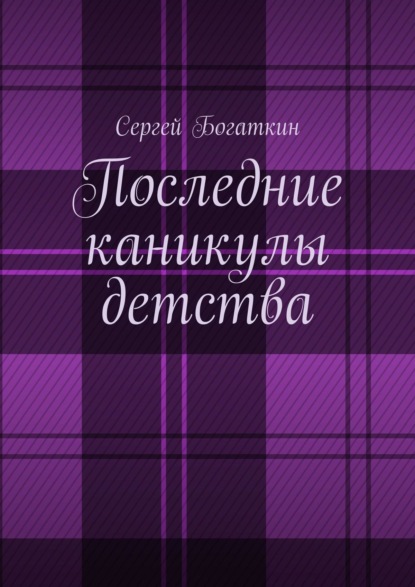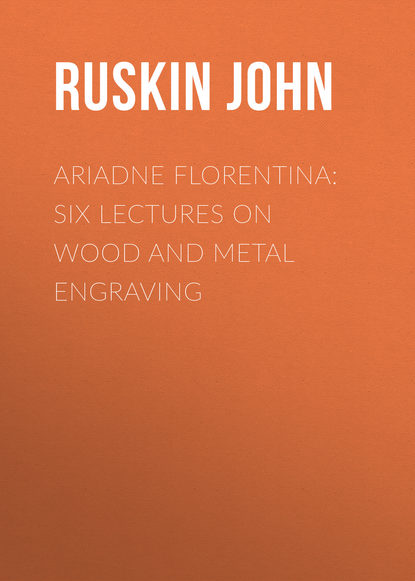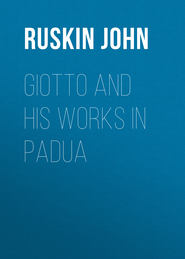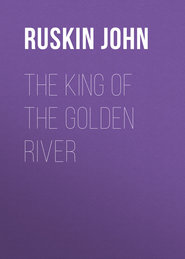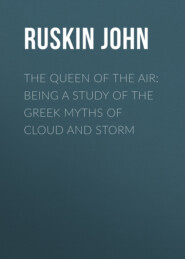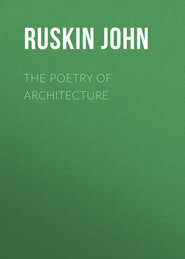По всем вопросам обращайтесь на: info@litportal.ru
(©) 2003-2024.
✖
Ariadne Florentina: Six Lectures on Wood and Metal Engraving
Автор
Год написания книги
2018
Настройки чтения
Размер шрифта
Высота строк
Поля
The Delineators;
The Chiaroscurists; and
The Colorists.
21. The Delineators are the men on whom I am going to give you this course of lectures. They are essentially engravers, an engraved line being the best means of delineation. The Chiaroscurists are essentially draughtsmen with chalk, charcoal, or single tints. Many of them paint, but always with some effort and pain. Lionardo is the type of them; but the entire Dutch school consists of them, laboriously painting, without essential genius for color.
The Colorists are the true painters; and all the faultless (as far, that is to say, as men's work can be so,) and consummate masters of art belong to them.
22. The distinction between the colorist and chiaroscurist school is trenchant and absolute: and may soon be shown you so that you will never forget it. Here is a Florentine picture by one of the pupils of Giotto, of very good representative quality, and which the University galleries are rich in possessing. At the distance at which I hold it, you see nothing but a checker-work of brilliant, and, as it happens, even glaring colors. If you come near, you will find this patchwork resolve itself into a Visitation, and Birth of St. John; but that St. Elizabeth's red dress, and the Virgin's blue and white one, and the brown posts of the door, and the blue spaces of the sky, are painted in their own entirely pure colors, each shaded with more powerful tints of itself,—pale blue with deep blue, scarlet with crimson, yellow with orange, and green with richer green.
The whole is therefore as much a mosaic work of brilliant color as if it were made of bits of glass. There is no effect of light attempted, or so much as thought of: you don't know even where the sun is: nor have you the least notion what time of day it is. The painter thinks you cannot be so superfluous as to want to know what time of day it is.
23. Here, on the other hand, is a Dutch picture of good average quality, also out of the University galleries. It represents a group of cattle, and a herdsman watching them. And you see in an instant that the time is evening. The sun is setting, and there is warm light on the landscape, the cattle, and the standing figure.
Nor does the picture in any conspicuous way seem devoid of color. On the contrary, the herdsman has a scarlet jacket, which comes out rather brilliantly from the mass of shade round it; and a person devoid of color faculty, or ill taught, might imagine the picture to be really a fine work of color.
But if you will come up close to it, you will find that the herdsman has brown sleeves, though he has a scarlet jacket; and that the shadows of both are painted with precisely the same brown, and in several places with continuous touches of the pencil. It is only in the light that the scarlet is laid on.
This at once marks the picture as belonging to the lower or chiaroscurist school, even if you had not before recognized it as such by its pretty rendering of sunset effect.
24. You might at first think it a painting which showed greater skill than that of the school of Giotto. But the skill is not the primary question. The power of imagination is the first thing to be asked about. This Italian work imagines, and requires you to imagine also, a St. Elizabeth and St. Mary, to the best of your power. But this Dutch one only wishes you to imagine an effect of sunlight on cow-skin, which is a far lower strain of the imaginative faculty.
Also, as you may see the effect of sunlight on cow-skin, in reality, any summer afternoon, but cannot so frequently see a St. Elizabeth, it is a far less useful strain of the imaginative faculty.
And, generally speaking, the Dutch chiaroscurists are indeed persons without imagination at all,—who, not being able to get any pleasure out of their thoughts, try to get it out of their sensations; note, however, also their technical connection with the Greek school of shade, (see my sixth inaugural lecture, § 158,) in which color was refused, not for the sake of deception, but of solemnity.
25. With these final motives you are not now concerned; your present business is the quite easy one of knowing, and noticing, the universal distinction between the methods of treatment in which the aim is light, and in which it is color; and so to keep yourselves guarded from the danger of being misled by the, often very ingenious, talk of persons who have vivid color sensations without having learned to distinguish them from what else pleases them in pictures. There is an interesting volume by Professor Taine on the Dutch school, containing a valuable historical analysis of the influences which formed it; but full of the gravest errors, resulting from the confusion in his mind between color and tone, in consequence of which he imagines the Dutch painters to be colorists.
26. It is so important for you to be grounded securely in these first elements of pictorial treatment, that I will be so far tedious as to show you one more instance of the relative intellectual value of the pure color and pure chiaroscuro school, not in Dutch and Florentine, but in English art. Here is a copy of one of the lost frescoes of our Painted Chamber of Westminster;—fourteenth-century work, entirely conceived in color, and calculated for decorative effect. There is no more light and shade in it than in a Queen of Hearts in a pack of cards;—all that the painter at first wants you to see is that the young lady has a white forehead, and a golden crown, and a fair neck, and a violet robe, and a crimson shield with golden leopards on it; and that behind her is clear blue sky. Then, farther, he wants you to read her name, "Debonnairete," which, when you have read, he farther expects you to consider what it is to be debonnaire, and to remember your Chaucer's description of the virtue:—
She was not brown, nor dun of hue,
But white as snowe, fallen new,
With eyen glad, and browes bent,
Her hair down to her heeles went,
And she was simple, as dove on tree,
Full debonnair of heart was she.
27. You see Chaucer dwells on the color just as much as the painter does, but the painter has also given her the English shield to bear, meaning that good-humor, or debonnairete, cannot be maintained by self-indulgence;—only by fortitude. Farther note, with Chaucer, the "eyen glad," and brows "bent" (high-arched and calm), the strong life, (hair down to the heels,) and that her gladness is to be without subtlety,—that is to say, without the slightest pleasure in any form of advantage-taking, or any shrewd or mocking wit: "she was simple as dove on tree;" and you will find that the color-painting, both in the fresco and in the poem, is in the very highest degree didactic and intellectual; and distinguished, as being so, from all inferior forms of art. Farther, that it requires you yourself first to understand the nature of simplicity, and to like simplicity in young ladies better than subtlety; and to understand why the second of Love's five kind arrows (Beauté being the first)—
Simplece ot nom, la seconde
Qui maint homme parmi le monde
Et mainte dame fait amer.
Nor must you leave the picture without observing that there is another reason for Debonnairete's bearing the Royal shield,—of all shields that, rather than another. "De-bonne-aire" meant originally "out of a good eagle's nest," the "aire" signifying the eagle's nest or eyrie especially, because it is flat, the Latin "area" being the root of all.
And this coming out of a good nest is recognized as, of all things, needfulest to give the strength which enables people to be good-humored; and thus you have "debonnaire" forming the third word of the group, with "gentle" and "kind," all first signifying "of good race."
You will gradually see, as we go on, more and more why I called my third volume of lectures Eagle's Nest; for I am not fantastic in these titles, as is often said; but try shortly to mark my chief purpose in the book by them.
28. Now for comparison with this old art, here is a modern engraving, in which color is entirely ignored; and light and shade alone are used to produce what is supposed to be a piece of impressive religious instruction. But it is not a piece of religious instruction at all;—only a piece of religious sensation, prepared for the sentimental pleasure of young ladies; whom (since I am honored to-day by the presence of many) I will take the opportunity of warning against such forms of false theological satisfaction. This engraving represents a young lady in a very long and, though plain, very becoming white dress, tossed upon the waves of a terrifically stormy sea, by which neither her hair nor her becoming dress is in the least wetted; and saved from despair in that situation by closely embracing a very thick and solid stone Cross. By which far-sought and original metaphor young ladies are expected, after some effort, to understand the recourse they may have, for support, to the Cross of Christ, in the midst of the troubles of this world.
29. As those troubles are for the present, in all probability, limited to the occasional loss of their thimbles when they have not taken care to put them into their work-boxes,—the concern they feel at the unsympathizing gayety of their companions,—or perhaps the disappointment at not hearing a favorite clergyman preach,—(for I will not suppose the young ladies interested in this picture to be affected by any chagrin at the loss of an invitation to a ball, or the like worldliness,)—it seems to me the stress of such calamities might be represented, in a picture, by less appalling imagery. And I can assure my fair little lady friends,—if I still have any,—that whatever a young girl's ordinary troubles or annoyances may be, her true virtue is in shaking them off, as a rose-leaf shakes off rain, and remaining debonnaire and bright in spirits, or even, as the rose would be, the brighter for the troubles; and not at all in allowing herself to be either drifted or depressed to the point of requiring religious consolation. But if any real and deep sorrow, such as no metaphor can represent, fall upon her, does she suppose that the theological advice of this piece of modern art can be trusted? If she will take the pains to think truly, she will remember that Christ Himself never says anything about holding by His Cross. He speaks a good deal of bearing it; but never for an instant of holding by it. It is His Hand, not His Cross, which is to save either you, or St. Peter, when the waves are rough. And the utterly reckless way in which modern religious teachers, whether in art or literature, abuse the metaphor somewhat briefly and violently leant on by St. Paul, simply prevents your understanding the meaning of any word which Christ Himself speaks on this matter! So you see this popular art of light and shade, catching you by your mere thirst of sensation, is not only undidactic, but the reverse of didactic—deceptive and illusory.
30. This popular art, you hear me say, scornfully; and I have told you, in some of my teaching in "Aratra Pentelici," that all great art must be popular. Yes, but great art is popular, as bread and water are to children fed by a father. And vile art is popular, as poisonous jelly is, to children cheated by a confectioner. And it is quite possible to make any kind of art popular on those last terms. The color school may become just as poisonous as the colorless, in the hands of fools, or of rogues. Here is a book I bought only the other day,—one of the things got up cheap to catch the eyes of mothers at bookstalls,—Puss in Boots, illustrated; a most definite work of the color school—red jackets and white paws and yellow coaches as distinct as Giotto or Raphael would have kept them. But the thing is done by fools for money, and becomes entirely monstrous and abominable. Here, again, is color art produced by fools for religion: here is Indian sacred painting,—a black god with a hundred arms, with a green god on one side of him and a red god on the other; still a most definite work of the color school. Giotto or Raphael could not have made the black more resolutely black, (though the whole color of the school of Athens is kept in distinct separation from one black square in it), nor the green more unquestionably green. Yet the whole is pestilent and loathsome.
31. Now but one point more, and I have done with this subject for to-day.
You must not think that this manifest brilliancy and Harlequin's-jacket character is essential in the color school. The essential matter is only that everything should be of its own definite color: it may be altogether sober and dark, yet the distinctness of hue preserved with entire fidelity. Here, for instance, is a picture of Hogarth's,—one of quite the most precious things we have in our galleries. It represents a meeting of some learned society—gentlemen of the last century, very gravely dressed, but who, nevertheless, as gentlemen pleasantly did in that day,—you remember Goldsmith's weakness on the point—wear coats of tints of dark red, blue, or violet. There are some thirty gentlemen in the room, and perhaps seven or eight different tints of subdued claret-color in their coats; and yet every coat is kept so distinctly of its own proper claret-color, that each gentleman's servant would know his master's.
Yet the whole canvas is so gray and quiet, that as I now hold it by this Dutch landscape, with the vermilion jacket, you would fancy Hogarth's had no color in it at all, and that the Dutchman was half-way to becoming a Titian; whereas Hogarth's is a consummate piece of the most perfect colorist school, which Titian could not beat, in its way; and the Dutchman could no more paint half an inch of it than he could summon a rainbow into the clouds.
32. Here then, you see, are, altogether, five works, all of the absolutely pure color school:—
1. One, Indian,—Religious Art;
2. One, Florentine,—Religious Art;
3. One, English,—from Painted Chamber, Westminster,—Ethic Art;
4. One, English,—Hogarth,—Naturalistic Art;
5. One, English,—to-day sold in the High Street,—Caricaturist Art.
And of these, the Florentine and old English are divine work, God-inspired; full, indeed, of faults and innocencies, but divine, as good children are.
Then this by Hogarth is entirely wise and right; but worldly-wise, not divine.
While the old Indian, and this, with which we feed our children at this hour, are entirely damnable art;—every bit of it done by the direct inspiration of the devil,—feeble, ridiculous,—yet mortally poisonous to every noble quality in body and soul.
33. I have now, I hope, guarded you sufficiently from the danger either of confusing the inferior school of chiaroscuro with that of color, or of imagining that a work must necessarily be good, on the sole ground of its belonging to the higher group. I can now proceed securely to separate the third school, that of Delineation, from both; and to examine its special qualities.
It begins (see "Inaugural Lectures," § 137) in the primitive work of races insensible alike to shade and to color, and nearly devoid of thought and of sentiment, but gradually developing into both.
Now as the design is primitive, so are the means likely to be primitive. A line is the simplest work of art you can produce. What are the simplest means you can produce it with?
A Cumberland lead-pencil is a work of art in itself, quite a nineteenth-century machine. Pen and ink are complex and scholarly; and even chalk or charcoal not always handy.
But the primitive line, the first and last, generally the best of lines, is that which you have elementary faculty of at your fingers' ends, and which kittens can draw as well as you—the scratch.
The first, I say, and the last of lines. Permanent exceedingly,—even in flesh, or on mahogany tables, often more permanent than we desire. But when studiously and honorably made, divinely permanent, or delightfully—as on the venerable desks of our public schools, most of them, now, specimens of wood engraving dear to the heart of England.
34. Engraving, then, is, in brief terms, the Art of Scratch. It is essentially the cutting into a solid substance for the sake of making your ideas as permanent as possible, graven with an iron pen in the Rock forever. Permanence, you observe, is the object, not multiplicability;—that is quite an accidental, sometimes not even a desirable, attribute of engraving. Duration of your work—fame, and undeceived vision of all men, on the pane of glass of the window on a wet day, or on the pillars of the castle of Chillon, or on the walls of the pyramids;—a primitive art,—yet first and last with us.
Since then engraving, we say, is essentially cutting into the surface of any solid; as the primitive design is in lines or dots, the primitive cutting of such design is a scratch or a hole; and scratchable solids being essentially three—stone, wood, metal,—we shall have three great schools of engraving to investigate in each material.
35. On tablet of stone, on tablet of wood, on tablet of steel,—the first giving the law to everything; the second true Athenian, like Athena's first statue in olive-wood, making the law legible and homely; and the third true Vulcanian, having the splendor and power of accomplished labor.

